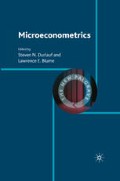Abstract
Suppose that ℱ = {F θ : θ ( S} is a parametric family of distributions on a sample space X, and let Q denote a probability distribution defined on the parameter space S. The distribution
is a mixture distribution. An observation X drawn from F q can be thought of as being obtained in a two-step procedure: first, a random Θ is drawn from the distribution Q and then, conditional on Θ = θ, X is drawn from the distribution F θ . Suppose we have a random sample X 1 ,…, X n from F q . We can view this as a missing data problem in that the ‘full data’ consists of pairs (X 1,Θ1),…, (X n ,Θ n ), with Θi ∼ Q and Xi|Θi = θ ∼ F θ , but then only the first member Xi of each pair is observed; the labels Θi are hidden.
Access this chapter
Tax calculation will be finalised at checkout
Purchases are for personal use only
Preview
Unable to display preview. Download preview PDF.
Bibliography
Lindsay, B.G. 1995. Mixture Models: Theory, Geometry and Applications, NSF-CBMS Regional Conference Series in Probability and Statistics, 5. Hayward, CA: Institute of Mathematical Statistics and American Statistical Association.
McLachlan, G. and Peel, D. 2000. Finite Mixture Models. New York: Wiley-Interscience.
Titterington, D.M., Smith, A.F.M. and Makov, U.E. 1985. Statistical Analysis of Finite Mixture Distributions. Chichester: John Wiley.
Tong, H. 1990. Nonlinear Time Series: A Dynamical System Approach. Oxford: Clarendon Press.
Wong, C.S. and Li, W.K. 2000. On a mixture autoregressive model. Journal of the Royal Statistical Society, Series B 62, 95–115.
Editor information
Editors and Affiliations
Copyright information
© 2010 Palgrave Macmillan, a division of Macmillan Publishers Limited
About this chapter
Cite this chapter
Lindsay, B.G., Stewart, M. (2010). Mixture Models. In: Durlauf, S.N., Blume, L.E. (eds) Microeconometrics. The New Palgrave Economics Collection. Palgrave Macmillan, London. https://doi.org/10.1057/9780230280816_17
Download citation
DOI: https://doi.org/10.1057/9780230280816_17
Publisher Name: Palgrave Macmillan, London
Print ISBN: 978-0-230-23881-7
Online ISBN: 978-0-230-28081-6
eBook Packages: Palgrave Media & Culture CollectionLiterature, Cultural and Media Studies (R0)

